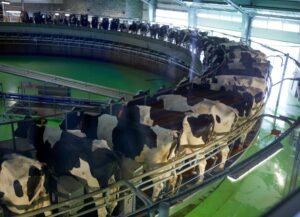Maria Villagrasa & Nuria Garcia
A negative energy balance of dairy cows at the beginning of the lactation delays the onset of normal ovarian activity. The energy deficit also alters the hormonal status, the number of estrus cycles is reduced, oocyte quality decreases and embryonic mortality increases. These factors reduce the efficiency of artificial insemination and the success of reproduction.
One strategy to alleviate the negative energy balance is to reduce the energy in milk by supplementing to reduce milk fat synthesis, which could reduce the mobilization of body fat to promote earlier ovulation and better gestation rates.
One of these supplements is fish oil (FO) administered at the beginning of the lactation which, in addition to a reduction in milk fat and thus negative energy balance, it is also rich in polyunsaturated fatty acids (FA), especially omega-3s, which are beneficial to reproduction in dairy cows.
Fish oil contains a high concentration of long-chain polyunsaturated FA, including eicosapentaenoic acid (EPA; C20:5 n-3) and docosahexaenoic acid (DHA; C22:6 n-3). These FA have been shown to improve reproductive functions through positive effects on the endocrine system, egg, embryo and prostaglandin synthesis.
Another benefit of the supplementation with FO is that causes a significant increase in the concentration of omega-3 acids in milk, which can be beneficial to human health.
On the other hand, it is also important to determine the amount of FO offered to dairy cows. Some studies indicate that the optimal amount of FO needed for its full effectiveness and to reduce any negative effects is between 55 and 120 g/day.
Since there are few studies evaluating the negative energy balance resulting from the addition of supplements that reduce milk fat synthesis, research (Swanepoel et al., 2020) was conducted to determine the impact of a FO based supplement on the production, energy balance, reproductive performance and health status of multiparous dairy cows. The FO supplement contained 41.0% FA, with 11.8% DHA (4.5%) and 6.21% EPA (2.5%).
In this study two groups of 310 cows received a total mixed ration and a fish oil supplement during 160 days in milk:
- Control group: no FO
- FO Group: 160 g/cow per day of FO(77 g of fish oil with 3.9 g of EPA and 7.2 g of DHA).
The nutritional composition of the two treatments was similar containing on a dry basis: dry matter 59.6%, protein 17.5%, Neutral detergent fiber 27.8%, acid detergent fiber 19.8%, lignin 4.50%, starch 19.9%. Fat and FA concentrations increased slightly with the addition of FO so that fat it went from 4.90% in the control to 5.20% in the FO diet, and FA went from 4.70% in the control to 4.90% in the FO diet.
On the other hand, FA profiles were very different with the inclusion of FO and significantly higher levels of C14:0 were observed (0.57 vs. 0.73 %), C15:0 (<0.01 vs. 0.08 %), C16:1 n-7 (0.44 vs. 0.61%), C17:0 (0.03 vs. 0.12 %), C20:1 (0.17 vs. 0.25%), EPA (<0.01 vs. 0.25%), and DHA (<0.01 vs. 0.48%).
Effect of fatty acids on dry matter intake and dairy production
Dry matter intake was not affected by treatment, with an average of 29.9 kg/cow per day. Milk production was higher in cows receiving FO (53.8 vs. 51.3 kg/day) as well as milk protein production (1.51 vs. 1.46 kg/day). The increase in milk production of almost 2.5 kg/day could be explained by the presence not only of a significant amount of DHA but of other long-chain omega-3s, especially high concentrations of EPA and omega docosapentaenoic acid (DPA), which may have contributed to ruminal lipid metabolism.
However, fat production was lower in the FO group of cows (1.74 vs. 1.83 kg/day), up to approximately 130 days in milk (DIM), and from then the cows in the FO group produced the highest fat. These results are consistent with other research suggesting that milk fat reduction is often associated with feeding polyunsaturated FA.
Somatic cell counts, a parameter associated with udder health and body weight scores were not affected by treatment.
Reproductive performance
As noted above, it has been well documented that omega-3 FA supplementation may benefit the reproductive performance of cows. In this case there was not a treatment effect so that it did not improve pregnancy rates during the first service.
Some studies indicate that the advantages of feeding FO do not occur until cows have received the supplement for at least 60 days, suggesting that more FA may be needed to build-up in the tissue and cause fertility responses. Since the amount of FA administered in this study was low, and cows were fed it only about 55 days before the first service, this may be one of the reasons for the lack of better performance on the first service.
On the other hand, the pregnancy rates on the second service improved numerically with the FO treatment, from 39.5 to 49.1% (it did not reach statistical significance however due to the low number of cows available for the second service). These data are also consistent with other studies indicating that pregnancy rate on the second AI often increased thanks to FO supplementation, suggesting that there is a positive impact of FO on ovulation in the second service.
Fatty acid profiles
There is a growing interest in increasing omega-3 concentration in meat and milk due to its health benefits in humans (i.e. cardiovascular disease). In this context, there was a marked increase in health-promoting FA potentially in the milk fat of cows receiving FO, such as C18:3 n-3 (0.045 vs. cows. 0.049), C20:5 n-3 (0.029 vs. 0.037), C22:5 n-3 (0.050 vs 0.058) and C22:6 n-3 (0.001 vs. 0.027).
Conclusions
The main findings of this study were as follows:
- Feeding 77 g/d of fish oil slightly reduced milk fat production and mitigated the negative energy balance at the beginning of the lactation without adversely affecting intake, milk protein, or cow health.
- Milk production increased by almost 2.5 kg/day.
- Pregnancy rates at first service did not improve with fish oil, however they improved on the second service.
- The milk of cows supplemented with fish oil had a higher concentration of very long chain FA, which can improve milk quality and be beneficial to human health.
Reference
N. Swanepoel, P.H. Robinson. Impacts of feeding a fish-oil based feed supplement through 160 days in milk on reproductive and productive performance, as well as the health, of multiparous early-lactation Holstein cows. Animal Feed Science and Technology 268 (2020) 114618.
© 2020 Dairy Knowledge Center. All Rights Reserved.











